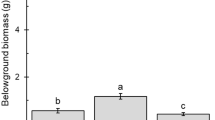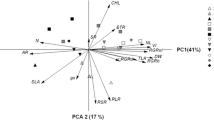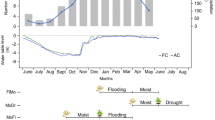Abstract
In recent decades, invasive shrubs have replaced herbaceous wetlands in many parts of the world. In Florida, the native shrub Salix caroliniana Michx. (Carolina willow) expanded its distribution throughout the upper St. Johns River, replacing herbaceous marshes with willow swamps. To identify ways to prevent its expansion, we experimentally tested the effects of watering regime, temperature, substrate, and seed source on willow germination and seedling survival. In growth chamber experiments, germination and survival were most affected by watering regime and were greatest in saturated, organic soils. Survival decreased with soil inundation and on drier, sandy soils. Variable texture and nutrient content in native soils had no differential effect on germination or survivability of willow. Time of seed production, seed source, and delay in watering significantly affected germination. Seed germination occurred quickly after being sown. However, seed viability declined just as quickly. Whenever a soil held sufficient water, especially through capillarity, seeds of Carolina willow germinated and survived well. Seasonal manipulation of water levels to flood marshes during seed-fall and to inundate willow seedlings provides managers with an effective strategy for reducing establishment of Carolina willow.




Similar content being viewed by others
References
Ainouche ML, Fortune PM, Salmon A, Parisod C, Grandbastien MA, Fukunaga K, Ricco M, Misset MT (2009) Hybridization, polyploidy and invasion: lessons from Spartina (Poaceae). Biological Invasions 11:1159–1173
Barnea A, Yom-Tov Y, Friedman J (1991) Does ingestion by birds affect seed germination? Functional Ecology 5:394–402
Crawley MJ (2007) The R book. John Wiley & Sons, Chichester
Dahl TE (2000) Status and trends of wetlands in the conterminous United States 1986 to 1997. U.S. Department of the Interior, Fish and Wildlife Service, Washington, D.C., 82 pp
Douglas DA (1995) Seed germination, seedling demography, and growth of Salix setchelliana on glacial river gravel bars in Alaska. Canadian Journal of Botany 73:673–679
Gladwin DN, Roelle JE (1998) Survival of plains cottonwood (Populus deltoides sub. sp. monilifera) and saltcedar (Tamarix ramosissima) in response to flooding. Wetlands 18:669–674
Global Invasive Species Database (GISD) (2013) Salix. Available from: http://www.issg.org/database/species/search.asp?sts=sss&st=sss&fr=1&x=0&y=0&sn=salix&rn=&hci=-1&ei=-1&lang=EN Accessed 14 January 2013
Gordon DR (1998) Effects of invasive, non-indigenous plant species on ecosystem processes: lessons from Florida. Ecological Applications 8:975–989
Griffin GF, Smith DS, Morton SR, Allan GE, Masters KA, Preece N (1989) Status and implications of the invasion of tamarisk (Tamarix aphylla) on the Finke River, Northern Territory, Australia. Journal of Environmental Management 29:297–315
Hall GB (1987) Establishment of minimum surface water requirements for the greater Lake Washington Basin. Technical Publication SJ87–3, St. Johns River Water Management District, Palatka, FL. 85 pp
Hanselman JA, Bush M, Lee MA (2005) Seed content and percent organic matter in surface sediments as indicators of wetland plant communities, Blue Cypress Marsh, Florida. Florida Scientist 68:250–260
Jones DT, Sah JP, Ross MS, Oberbauer SF, Hwang B, Jayachandran K (2006) Responses of twelve tree species common in Everglades tree islands to simulated hydrologic regimes. Wetlands 26:830–844
Johnson KG, Allen MS, Havens KE (2007) A review of littoral vegetation, fisheries, and wildlife responses to hydrologic variation at Lake Okeechobee. Wetlands 27:110–126
Karrenberg S, Edwards PJ, Kollmann J (2002) The life history of Salicaceae living in the active zone of floodplains. Freshwater Biology 47:733–748
Keddy PA, Constabel P (1986) Germination of ten shoreline plants in relation to seed size, soil particle size and water level: an experimental study. Journal of Ecology 74:133–141
Kinser P, Lee MA, Dambek G, Williams M, Ponzio KJ, Adamus C (1997) Expansion of Carolina willow in the Blue Cypress Marsh Conservation Area, Upper St. Johns River Basin. Professional Paper SJ97–PP1, St. Johns River Water Management District, Palatka, Florida. 13 pp
Kuzovkina YA, Quigley MF (2005) Willows beyond wetlands: uses of Salix L. species for environmental projects. Water, Air, & Soil Pollution 162:183–204
Liotta J (2001) Rasgos biológicos de Salix humboldtiana Willd. y régimen de pulsos de inundación. Interciencia 26:397–403
Lowe EF, Brooks JE, Fall CJ, Gerry LR, Hall GB (1984) U.S. EPA Clean Lake Program, Phase I Diagnostic-Feasibility study of the Upper St. Johns River Chain of Lakes, Volume 1 – Diagnostic Study. Technical Publication SJ 84–15. St. Johns River Water Management District, Palatka, FL
Lowe S, Browne M, Boudjelas S, De Poorter M (2004) 100 of the world’s worst invasive alien species: a selection from the Global Invasive Species Database. Published by The Invasive Species Specialist Group (ISSG), a specialist group of the Species Survival Commission (SSC) of the World Conservation Union (IUCN), 12 pp
Martin TD, Brockhoff CA, Creed JT, EMMC Methods Work Group (1994) Determination of metals and trace elements in water and wastes by inductively coupled plasma-atomic spectrometry. Method 200.7, Revision 4.4. Environmental Monitoring Systems Laboratory, Office of Research and Development, U.S. Environmental Protection Agency, Cincinnati, Ohio
McLeod KW, McPherson JK (1973) Factors limiting the distribution of Salix nigra. Bulletin of the Torrey Botanical Club 100:102–110
Miller SJ, Ponzio KJ, Lee MA, Keenan LW, Miller SR (1998) The use of fire in wetland preservation/restoration: are there risks? Pp. 127–139 in T.L. Pruden and L.A. Brennen, eds., Fire in Ecosystem Management: Shifting the Paradigm from Suppression to Prescription. Proceedings of the Tall Timbers Fire Ecology Conference, No. 20, May 22–25, 1996, Boise, Idaho
Morisette JT, Jarnevich CS, Ullah A, Cai W, Pedelty JA, Gentle JE, Stohlgren TJ, Schnase JL (2006) A tamarisk habitat suitability map for the continental United States. Frontiers in Ecology and the Environment 4:11–17
Newman S, Grace JB, Koebel JW (1996) Effects of nutrients and hydroperiod on Typha, Cladium and Eleocharis: implications for Everglades restoration. Ecological Applications 6:774–783
Niiyama K (1990) The role of seed dispersal and seedling traits in colonization and coexistence of Salix species in a seasonally flooded habitat. Ecological Research 5:317–331
O’Dell J (1993a) (ed.) Determination of Ammonia Nitrogen by semi-automated colorimetry. Method 350.1. Environmental Monitoring Systems Laboratory, Office of Research and Development, U.S. Environmental Protection Agency, Cincinnati, Ohio
O’Dell J (1993b) (ed.) Determination of Nitrate-Nitrite Nitrogen by automated colorimetry. Method 353.2. Environmental Monitoring Systems Laboratory, Office of Research and Development, U.S. Environmental Protection Agency, Cincinnati, Ohio
O’Dell J (1993c) (ed.) Determination of Phosphorus by semi-automated colorimetry. Method 365.1 Environmental Monitoring Systems Laboratory, Office of Research and Development, U.S. Environmental Protection Agency, Cincinnati, Ohio
Ponzio KJ (1998) Effects of various treatments on the germination of Sawgrass, Cladium jamaicense Cranz, seeds. Wetlands 18:51–58
Ponzio KJ, Miller SJ, Underwood E, Rowe SP, Voltolina DJ, Miller TD (2006) Responses of a willow (Salix caroliniana Michx.) community to roller-chopping. Natural Areas Journal 26:53–60
Quintana-Ascencio PF, Fauth JE, Castro-Morales LM, Ponzio KJ, Hall D, Snyder K (2013) Taming the beast: managing hydrology to control Carolina Willow (Salix caroliniana) seedlings and cuttings. Restoration Ecology 21:639–647
Reyes MJ (2012) Use of adventitious roots for the determination of hydroperiod in isolated wetlands. Doctoral dissertation. University of South Florida, Tampa, Florida
Rodgers JA (1989) Willowy species. Aquatics 11:4–8
Sacchi CF, Price PW (1992) The relative roles of abiotic and biotic factors in seedling demography of arroyo willow (Salix lasiolepis: Salicaceae). American Journal of Botany 79:395–405
Saintilan N, Williams RJ (1999) Mangrove transgression into saltmarsh environments in south-east Australia. Global Ecology and Biogeography 8:117–124
Serbesoff-King K (2003) Melaleuca in Florida: a literature review on the taxonomy, distribution, biology, ecology, economic importance and control measures. Journal of Aquatic Plant Management 41:98–112
Seiwa K, Tozawa M, Ueno N, Kimura M, Yamasaki M, Maruyama K (2008) Roles of cottony hairs in directed seed dispersal in riparian willows. Plant Ecology 198:27–35
Sher AA, Marshall DL, Taylor JP (2002) Establishment patterns of native Populus and Salix in the presence of invasive nonnative Tamarix. Ecological Applications 12:760–772
Siegel RS, Brock JH (1990) Germination requirements of key southwestern woody riparian species. Desert Plants 10:3–8
Shipley B, Parent M (1991) Germination responses of 64 wetland species in relation to seed size, minimum time to reproduction and seedling relative growth rate. Functional Ecology 5:111–118
Southall EJ, Dale MP, Kent M (2003) Floristic variation and willow carr development within a southwest England wetland. Applied Vegetation Science 6:63–72
Splunder IV, Coops H, Voesenek LACJ, Blom CWPM (1995) Establishment of alluvial forest species in floodplains: the role of dispersal timing, germination characteristics and water level fluctuations. Acta Botanica Neerlandica 44:269–278
St. Johns River Water Management District (SJRWMD) (2007) Upper St. Johns River Basin, Surface Water Improvement and Management Plan. St. Johns River Water Management District, Palatka, 39 pp
Stromberg JC, Lite SJ, Marler R, Paradzick C, Shafroth PB, Shorrock D, White JM, White MS (2007) Altered stream-flow regimes and invasive plant species: the Tamarix case. Global Ecology and Biogeography 16:381–393
R Development Core Team (2011) R: A Language and Environment for Statistical Computing. R Foundation for Statistical Computing, Vienna, http://www.R-project.org
Taiz L, Zeiger E (2002) Plant physiology, 3rd edn. Sinauer Associates, Sunderland
Tallent-Halsell NG, Walker LR (2002) Responses of Salix gooddingii and Tamarix ramosissima. Wetlands 22(2):776–785
Taylor JP, McDaniel KC (1998) Restoration of saltcedar (Tamarix sp.)-infested floodplains on the Bosque del Apache National Wildlife Refuge. Weed Technology 12:345–352
Titus JH (1991) Seed bank of a hardwood floodplain swamp in Florida. Castanea 56:117–127
Traveset A, Riera N, Mas RE (2001) Passage through bird guts causes interspecific differences in seed germination characteristics. Functional Ecology 15:669–675
United States Department of Agriculture. Soil Conservation Service (1974) Soil Survey of Brevard County, Florida. http://ufdc.ufl.edu/UF00026071/00001. Accessed November 27, 2013
United States Department of Agriculture. Soil Conservation Service (1989) Soil Survey of Orange County, Florida. http://ufdc.ufl.edu/UF00025733/00001/. Accessed November 27, 2013
United States Department of Agriculture. Soil Conservation Service (1990) Soil Survey of Seminole County, Florida. http://ufdc.ufl.edu/UF00025738/00001/. Accessed November 27, 2013
Urban NH, Davis SM, Aumen NG (1993) Fluctuations in sawgrass and cattail densities in Everglades Water Conservation Area 2A under varying nutrient, hydrologic and fire regimes. Aquatic Botany 46:203–223
Young JA, Clements CD (2003) Seed germination of willow species from a desert riparian ecosystem. Journal of Range Management 56:496–500
Zedler JB, Kercher (2004) Causes and consequences of invasive plants in wetlands: opportunities, opportunists, and outcomes. Critical Reviews in Plant Sciences 23: 431–452.
Zukowski S, Gawne B (2006) Potential Effects of Willow (Salix spp.) Removal on FreshwaterEcosystem Dynamics. A Literature Review. Report for the North East Catchment Management Authority. Murray-Darling Freshwater Research Centre, Wodonga
Acknowledgments
We thank the staff of the St. Johns River Water Management District for providing access to sites. We thank M. Ferrer, B. Stephens, Jennifer Navarra, and graduate students from the Restoration Ecology class: C. Brescacin, S. Haynes, M. Gordon, K. Grablow, L. Souto, J. Waddell, A. Weiler-Lazarz and L. Sánchez for help during the initial project stages and with soil and seed sampling. Lisa McCauley assisted with GIS and L. Pearman from the U. S. Geological Survey provided temperature data. This project was supported by the St. Johns River Water Management District.
Author information
Authors and Affiliations
Corresponding author
Rights and permissions
About this article
Cite this article
Castro-Morales, L.M., Quintana-Ascencio, P.F., Fauth, J.E. et al. Environmental Factors Affecting Germination and Seedling Survival of Carolina Willow (Salix Caroliniana). Wetlands 34, 469–478 (2014). https://doi.org/10.1007/s13157-014-0513-6
Received:
Accepted:
Published:
Issue Date:
DOI: https://doi.org/10.1007/s13157-014-0513-6




